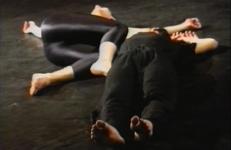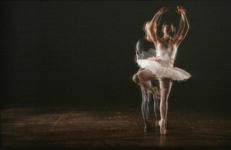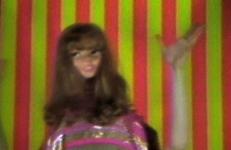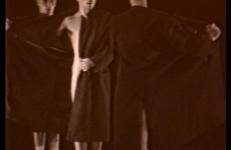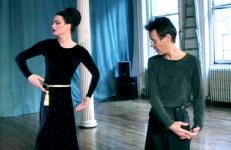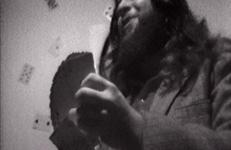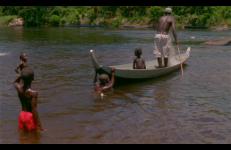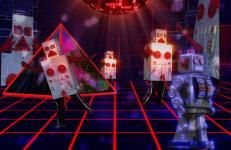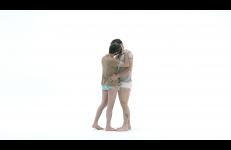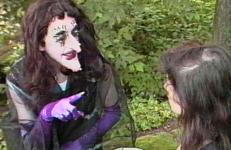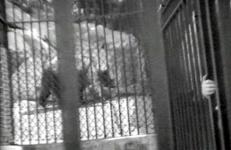Unlike other sectors of Romanian civil society who gained status after December 1989, the gay community struggled for many more years with a legal ban imposed by a conservative political class subservient to the Orthodox Church. Against this background, I planned to make a tactical video whose leitmotif was a pas de deux performed by two male dancers.
Dance
The orchestra begins and a male and female dancer move from opposite sides of the stage. The dancers embrace and begin the White Swan pas de deux from the ballet Swan Lake. However this is not the ballet as it is normally performed. The choreography has been re-staged so that in every single frame the two original dancers have been replaced by the bodies of four new dancers. The movement remains continuous, the characteristics of the dancers’ movements and gestures the same, but in each frame a different person occupies the dancers’ body spaces.
In this early Tom Rubnitz, Barbara Lipp and Tom Koken collaboration, "Frieda" performs her rap song with a bevy of dolls as back-up singers and dancers. Features rock-bottom production values and song lyrics by Barbara Lipp and Tom Koken.
In this early Tom Rubnitz, Barbara Lipp and Tom Koken collaboration, "Frieda" performs her rap song with a bevy of dolls as back-up singers and dancers. Features rock-bottom production values and song lyrics by Barbara Lipp and Tom Koken.
In this early Tom Rubnitz, Barbara Lipp and Tom Koken collaboration, "Frieda" performs her rap song with a bevy of dolls as back-up singers and dancers. Features rock-bottom production values and song lyrics by Barbara Lipp and Tom Koken.
This lyrical piece celebrates the male body simply and elegantly. Its subject, Christophe, is exquisitely portrayed by the sepia-toned balletic video. Three men dressed in overcoats dance in and out of the frame in front of a mostly stationary camera. Occasionally they open or partially remove the overcoats to display beautifully sculpted male bodies.
"In the spring of 2002 I handed over to Charles Atlas a collection of films and videotapes in various formats that I had been accumulating with an eye to his editing them into what I call a "faux Rainer portrait" (though he may well call the final product something else).
Designed as the centerpiece of Eiko & Koma’s three-year Retrospective Project, Raven is a radically scalable work. It can be performed in a theater, a gallery, outdoors, or at any other special site, and its length can vary depending on the context of the presentation. Raven’s genesis is in the concept underlying Eiko & Koma’s 1991 Land. The earth is precious in part because it can be unyielding. The landscape does not squander its riches on us; we have to negotiate our survival.
Eiko edited this video to illuminate, in fast pace, her solo performance project A Body in Places. The red cloth she often uses in her performance is used as a visual link between different places and communities where Eiko performed.
Eiko performed unannounced in the Cathedral of St. John Divine, New York City as an artist in residence in 2016-2018.
Camera by Alexis Moh.
Shot during the fall of 2009 in Wesleyan University, this short documentary follows Eiko & Koma as they construct the first exhibition of their Retrospective and ponder upon questions the project asks. Directed and edited by Joanna Arnow.
Shot by Mary Curtis Ratclif at the O.K. Harris Gallery on Prince and Green Streets, New York, this tape focuses on performer “Ricky Jay” as he performs card tricks at his magic table for an enthusiastic audience.
Polished obsidian mirrors, tezcatl, were once used in ancient Mexico for divination, to traverse into the worlds of the gods and ancestors.
Through the obsidian mirror, the solar and lunar ritual used to be a celestial dance. In Ritual, suns and moons whirl around, glowing brighter as their paths cross.
“Animists are people who recognise that the world is full of persons, some of whom are human, and that life is always lived in relationship with others.”
-- Graham Harvey, Animism
Trance dance and water implosion, a kino-line drawn between secular freak-outs and religious phenomena. Filmed in a single take at a sacred site on the Upper Suriname River, the minor secrets of a Saramaccan animist's everyday are revealed as time itself is undone. Rites are the new Trypps -- embodiment is our eternal everything.
Inspired in part by the cover of "Megatron Man," Patrick Cowley's archetypal 80s disco album, Robot Love is a celebration of the playful, synthetic, party-driven, disposable culture of disco. The video is playful and opulent, presenting a night at the disco as a mind-expanding trip to an alternate universe.
Inspired in part by the cover of "Megatron Man," Patrick Cowley's archetypal 80s disco album, Robot Love is a celebration of the playful, synthetic, party-driven, disposable culture of disco. The video is playful and opulent, presenting a night at the disco as a mind-expanding trip to an alternate universe.
Filmed during a trip sponsored by UCLA CAPS in 2019.
Camera by Alexis Moh.
Edited by Eiko Otake.
Rust was commissioned by the American Dance Festival and performed on chain-link fences hung vertically in the center of the stage. Performed nude in silence.
On September 11, 2021, Eiko Otake performed at 7am and 6pm at Belvedere Plaza in Battery Park City by the Hudson River, directly west of where the Twin Towers once stood. This video work is from the 6pm performance.
(tell me why): The Epistemology of Disco is an often humorous, at times sarcastic and poignant look at the role that disco music has played in the formation of gay male identity.
Commissioned by Lower Manhattan Cultural Council (LMCC) for the occasion of Eiko receiving the Sam Miller Performing Arts Award. Premiered at LMCC’s A Toast to Downtown on December 9, 2020. Shot at LMCC’s Arts Center at Governors Island.
Performer Eiko Otake.
Director/Editor Liz Sargent.
DP Minos Papas.
Production by Cyprian Films, New York.
The End of Time is a choreography for two lovers, enacted by three figures. It looks at the birth and the vanishing of desire as an endless chain with successive beginnings and endings.
"The End of Time (2012), is a choreography enacted by three figures exchanging between dominant and fragile roles. In each of the three chapters of the film, two men interpret the falling in and falling out of love, playing attraction and repulsion, taking off clothes and putting them on in what seems an eternal fable about love and separation."
Based on a tale by Charles Perrault, Tom Rubnitz's The Fairies comes complete with frogs, princes, kind fairies, and evil stepsisters—all costumed à la Rubnitz. Featuring Sister Dimension as the fairy godmother, Michael Clark, and others, the tape playfully illustrates a familiar fairytale moral, as each person gets what they deserve. The evil girl spits up toads, while flowers and jewels emerge from the mouth of Matilda the Good, and a dancing prince carries her away.
Their first longer piece entirely in silence. The backdrop and floor were painted with a burned flour paste which crumbled down as they moved. In bright light, Eiko & Koma became thirstier as the four sections progressed, seeking both water and intimacy in an extreme setting.
Forti uses the camera as a research tool to record the movements of three grizzly bears pacing anxiously behind the bars of their cage in the Brooklyn Zoo. The collected visual information becomes part of the basis for Forti's movements in Solo No. 1.




